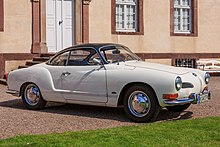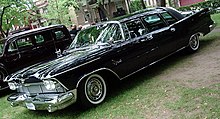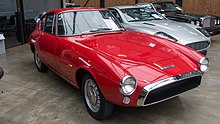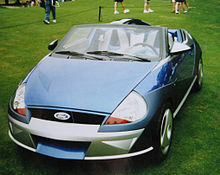Carrozzeria Ghia
| Ghia SpA | |
|---|---|
| legal form | società per azioni |
| founding | 1916 |
| Seat | Turin , Italy |
| Branch | Automotive industry |
The Carrozzeria Ghia SpA [ 'gia ] ( not [ ' dʒia ]) is an Italian design company, specializing in the design of design studies is specialized and prototype cars. Until the 1960s, Ghia also manufactured complete automobile bodies in small series, which were occasionally sold under their own brand names. In the German-speaking countries, the company was best known for the VW "Karmann-Ghia" . After Ghia had maintained close relationships with Chrysler for a number of years , the company has been part of the Ford group since 1970 , which had the first series of the Fiesta compact car designed here. For many years, Ford also used the name Ghia as a designation for particularly high-quality equipment variants of its large-scale models.
Company history
The Carrozzeria Ghia was founded in 1916 (according to other sources: 1915 or 1921) by Giacinto Ghia in Turin . Ghia managed the company until his death in 1944. In the same year Felice Mario Boano and Giorgio Alberti took over the majority of the shares. In 1951, Luigi Segre von Boano was accepted into the company as the new managing director. Segre advocated and pushed Ghia's orientation towards American corporations, while Boano wanted to establish Carrozzeria primarily as a supplier and service provider for the Italian automotive industry. Since the differences of opinion about Ghia's future could not be settled, Boano left the company in 1954 and founded his own body shop with Carrozzeria Boano . He later worked for Fiat's own Centro Stile. Segre then took over the Carrozzeria Ghia completely and remained its owner until his death in 1963.
In the early to mid-1950s, there was a rapid upswing in those Italian bodywork companies that were financially and organizationally able to set up larger production facilities in order to make the change from individual craftsmanship to industrial small-scale production. Ghia's competitors Bertone and Pininfarina had already moved into new, large factories on the outskirts of Turin and benefited from production orders from Alfa Romeo and Fiat . Under the leadership of Segre, Ghia also tried to gradually expand production capacities.
In 1954 Ghia acquired the competing Turin company Carrozzeria Stabilimenti Monviso . The acquisition also included the company Societa Apparecchi OS , which was active as a supplier to the automotive industry and as a manufacturer of stationary engines. As a result, Ghia moved its headquarters from Via Tommaso Grosso to the larger Monviso building on Corso Unione Sovietica, 75. It soon became apparent that this step could not sufficiently expand production capacities. Segre therefore decided to build new, significantly larger production halls on the outskirts of Turin on Via Agostini da Montefeltro, 5, which served as the company headquarters from 1957 until the end of the company.
At the same time there was a collaboration with Pietro Frua under the direction of Segres . In the summer of 1957 Ghia took over the Carrozzeria Pietro Frua . Ghia wanted to use the established name Frua for individual creations that were not compatible with the previous profile of the Ghia brand. The deal also included the appointment of Pietro Frua as Ghia's head of design. Under Frua's aegis, Ghia developed, among other things, the design for the body of the Renault Floride . About the authorship of the design, there were disputes between Luigi Segre and Pietro Frua, as a result of which Frua left the Carrozzeria Ghia and set up again in Turin with the Studio Tecnico Pietro Frua .
At the end of the 1950s there was a need for even larger production capacities and an old, abandoned ammunition factory was located opposite the Ghia property on Via Agostino da Montefeltro, 10-12-14. Segre saw the possibility of increasing body production there to five-digit numbers per year. However, at that time the Ghia company did not have sufficient funds to set up such a plant on its own. In 1960, the company Officine Stampaggi Industriali (OSI) SpA was founded , in which Ghia in the person of Luigi Segre and the industrialist Arrigo Olivetti, through one of his companies, the automotive supplier and rim manufacturer Fergat SpA, each held half. The Ghia subsidiary Societa Apparecchi OS was converted to OSI for this purpose.
In addition to the production of ever larger numbers of series vehicles, Ghia continued to employ its own vehicle designers and worked with well-known external designers in order to regularly present sensational individual items at the major automobile fairs. For this purpose, the company also had its own prototype department. For reasons of capacity, however, individual orders were repeatedly awarded to smaller, independent, handcrafted companies, such as the prototype workshop of the Basano brothers; this resulted in the Carrozzeria Sibona-Basano in 1962 , when the Ghia employee Pietro Sibona merged with the Basano brothers.
The death of Luigi Segre in February 1963 at the age of 44 marked a major turning point in the history of the Ghia company. He died in connection with an appendix operation which he had undergone immediately after his return from a professional stay in the USA. As a result, Olivetti took over the Ghia / Segre stake in OSI through Fergat and Ghia concentrated under new management on the former core areas of automobile design as well as the construction of individual pieces and smaller series.
Against this background, the time between 1963 and 1966 was restless for Ghia. In 1966, ex-General Ramfis Trujillo (1929-1969, actually Rafael Leónidas Trujillo Martínez ) acquired the company. He was the eldest and adopted son of the dictator of the Dominican Republic , Rafael Trujillo, who was murdered in 1961, and he was in exile in Spain as his former military ruler. Alternatively, a single source names Leonidas Ramades Trujillo (1942–1994) as the buyer. He was a son of Rafael Trujillo from his third marriage. The Carozzeria was up for sale again in 1967. The new owner was the Argentine entrepreneur Alejandro de Tomaso , who had been manufacturing racing and sports cars in Italy with De Tomaso and Scuderia De Tomaso since the late 1950s . De Tomaso also failed to operate Ghia profitably. 1970 de Tomaso sold the Carrozzeria to the US American Ford group, which has since been the owner of the company and the trademark rights.
Ghias designer
Well-known designers at Carrozzeria Ghia were Mario Felice Boano, Luigi Segre, Giovanni Savonuzzi , Pietro Frua, Giorgetto Giugiaro and Tom Tjaarda .
Ghias vehicles
The beginnings
In the 1920s, Carrozzeria Ghia made a name for itself as the bodybuilder of extravagant vehicles with chassis from Alfa Romeo , Fiat and Lancia . In the 1920s, numerous light metal bodies were created that were also used by customers at automobile sport events such as the Mille Miglia .
Orientation towards America: dream cars and small series
After the Second World War, Ghia sought the US large-scale manufacturers as a target group, as the Italian market was initially not receptive to costly studies. From 1950, through the designer Virgil Exner , there was a business relationship with the Chrysler Group that lasted into the 1960s. Ghia manufactured numerous exhibition vehicles ( Dream Cars ) for Chrysler. From some of them small series models developed, which were manufactured at Ghia and partly sold under their own name.
Chrysler
The first show car Ghia made for Chrysler was the 1950 Plymouth XX500 , a Boano-designed pontoon- style hatchback sedan . Ghia was at the time in competition with Pininfarina , who also tried to establish a relationship with Chrysler. Chrysler preferred Ghia because their work was far cheaper. By 1959, numerous other concept vehicles for all brands of the Chrysler group followed, with Ghia often taking up Exner's designs and refining them in detail. The most famous dream cars of this era were the Chrysler Norseman , Chrysler Plainsman and Plymouth Explorer (1953), which in profile and various details anticipated the lines of the Karmann Ghia, which was mass-produced from 1955. An outstanding creation was the Ghia Gilda from 1955, the name of which was reminiscent of the film of the same name with Rita Hayworth . The Gilda was a wedge-shaped coupé with folding headlights and high tail fins developed in the Turin wind tunnel, which Giovanni Savonuzzi designed for Chrysler, albeit without Exner's participation. Designed to accommodate a gas turbine, the Gilda was actually equipped with an OSCA four-cylinder engine. Stylistically, he anticipated the development of the tail fins in the late 1950s.
Ghia produced small series of some of these dream cars that were sold to European and American customers. This applied, among other things, to the Chrysler Ghia Special GS-1 from 1954, 400 of which were sold through Société France Motors.
The connection to Chrysler continued into the 1960s. During this time Ghia regularly produced the Crown Imperial sedan , a representative vehicle based on the second generation of Chrysler's top brand Imperial . A total of 132 limousines with an extended wheelbase. After the contract with Chrysler expired, Ghia sold the tools to the Spanish company Barreiros , which continued the production of long Chrysler sedans with Ghia know-how for two years.
Dual Ghia
As an indirect consequence of working for Chrysler, there was a business relationship with the US truck manufacturer Dual Motors . Dual had acquired the rights to the Dream Car Dodge Firearrow IV designed by Virgil Exner and manufactured by Ghia in 1954 and had the model mass-produced by Ghia with minor modifications using Dodge technology. By 1958, 102 convertibles and two coupés of the vehicle called Dual Ghia had been built. It became known beyond the USA through Billy Wilder's feature film Kiss Me, Fool , in which it is assigned to the leading actor Dean Martin ; the car used in the film was Martin's private car. A second, similarly designed series called 6.4L was also built by Ghia from 1961 to 1963 with a modified body. Only 26 vehicles from this series were built. The model was also offered in Germany; its purchase price was DM 60,000.
Eugene "Gene" Casaroll, the owner of Dual Motors and initiator of the Dual Ghia, later tried to revive the Duesenberg brand . A prototype of the Duesenberg Model D designed by Virgil Exner for this purpose was also built at Ghia in 1965.
Ghia and Fiat
Parallel to the projects with Chrysler, Ghia has been developing sporty or luxurious vehicles with Fiat technology on a regular basis since the late 1950s , many of which were produced in small series and in some cases marketed under Ghia's own name. One of the first Fiat-based models was the Fiat 1500 GT (later: Ghia 1500 GT , in the USA: Krim-Ghia ), a "Baby Ferrari" sports car with a hatchback body with the technology of the Fiat 1500 and one from Abarth tuned four-cylinder engine, of which around 300 copies were made between 1962 and 1966.
Ghia also designed special versions of the larger Fiat 2300 . This included above all the 2300 Coupé with notchback - the "Ferrari of the little man" - which was branded Fiat and was regularly sold through Fiat dealers. The production of this model, of which a total of over 3500 copies were made, was not carried out at Ghia for capacity reasons, but at the competitor OSI , whose production facilities were designed for larger quantities. Other special versions were the hatchback coupé 2300 Club with a large tailgate hinged at the top and the Cabriolet 2300 S, each of which was manufactured in small series at Ghia.In only four copies, Ghia finally produced the Ghia 230 S , which is sold under its own brand name, and whose completely independent body has no reference to the factory 2300 had.
Ghia and Giorgetto Giugiaro
In December 1965, Giorgetto Giugiaro, who had previously worked for Bertone, became Ghias chief designer. Within a short period of time, Giugiaro developed studies for Volkswagen and Isuzu , and later also the Isuzu 117 sports coupé, which was produced in series . For De Tomaso he designed the prototype Pampero - an open version of the Vallelunga - as well as the Mangusta , De Tomaso's first mid-engine sports car with American engines. Giugiaro's most sensational work for Ghia, however, was the design of the Maserati Ghibli, which was realized in just three months . The Ghibli, which was based on a study that Ghia had exhibited at the Turin Motor Show in 1964, was widely praised when it was presented in 1966 and is still considered one of the most beautiful sports cars 50 years after its debut. Giugiaro still considers the Ghibli to be his most beautiful creation. Giugiaro left Ghia after disagreements with the new owner Alejandro De Tomaso, and shortly afterwards founded his own design studio ItalDesign . His successor at Ghia was the American Tom Tjaarda.
De Tomaso
Alejandro de Tomaso took over the company in 1968. In this he was Rowan Industries someone a US oil production companies based in New Jersey .
During this phase, the De Tomaso Pantera was created .
Chrysler had terminated the lucrative contract for the construction of the Crown Imperial sedans in 1965 because the company supposedly wanted to withdraw from this market segment. Stageway Coaches jumped into the breach in Fort Smith ( Arkansas ), where such vehicles were built until 1971 and in cooperation with Chrysler. In addition, Imperial offered a Mobile Executive equipment package that turned the Crown Imperial into a mobile office and contained many elements of the Ghia Imperial. The request from Rowan Industries regarding the construction of a chauffeur-driven limousine based on the Checker Marathon should have been convenient for the angry de Tomaso against this background. Rowan planned to expand into the limo business and wanted to explore the possibilities. At Ghia, Tjaarda and Giugiaro were commissioned with the project. A competitor product to the Cadillac Series 75 and the stretch versions of the Lincoln Continental built by Lehmann-Peterson were considered . The vehicle was named Ghia Centurion and was a modern interpretation of the chauffeur-driven limousine. Traditionally, the interior was divided up with a partition, leather seats for the driver and high-quality fabric covers for the passengers. The motor journalist David Burgess-Wise commented on the vehicle that it was designed for hat wearers and Car and Driver even saw the Mafia as possible customers. The vehicle itself was drawn with restraint and shows similarities with the Fiat 130 , especially in the front area . Ghia first showed the Centurion at the Paris Motor Show in 1968 and at the NAIAS in 1969; NAIAS 1968 also mentions a single source. Rowan Industries did not pursue the idea any further and Morris Markin of Checker Motors was not interested. So it stayed with this unique piece that still exists.
ford
After De Tomaso had sold his shares in 1970, "Ghia" was integrated into the Ford group together with Carrozzeria Vignale , which was bought up in the same year . Tom Tjaarda was the chief designer until 1977, which in the automotive world was sometimes perceived with amusement. It was criticized that the American Ford group had spent a lot of money on two exotic styling companies, only to have them run by a designer born in Detroit. Tjaarda initially designed several other models for De Tomaso, including the Deauville sedan based on the Jaguar XJ , which was produced in small series until 1988, as well as the Mustela and Pantera 4 concept vehicles. Ghias' most successful project in the Ford era was the conception of the Ford Fiesta, the design of which Tjaarda significantly influenced. From the 1980s, Ford had Ghia draft numerous studies for the parent brand, but also for other companies belonging to the group. One of them was the Ghia Seatta, an open vehicle based on the Ford Ka . Ghia also developed concept vehicles for the British sports car manufacturer AC .
In addition, Ford used the name Ghia from the 1970s to around 2010 in almost all markets as a designation for particularly high-quality equipment versions of its production models.
gallery
literature
- Georg Amtmann, Halwart Schrader : Italian sports cars . Motorbuch-Verlag, Stuttgart 1999, ISBN 3-613-01988-4 .
Web links
Individual evidence
- ^ A b c d Dennis Adler: Chrysler . MotorBooks International, 2000, ISBN 9781610608718 , p. 84.
- ^ A b c Georg Amtmann, Halwart Schrader: Italian sports cars . Motorbuch-Verlag, Stuttgart 1999, ISBN 3-613-01988-4 . P. 186.
- ↑ a b c The history of the Ghia company on the web portal osicar.de ( Memento of the original from January 26, 2016 in the Internet Archive ) Info: The archive link has been inserted automatically and has not yet been checked. Please check the original and archive link according to the instructions and then remove this notice. , accessed January 26, 2016.
- ↑ Vita Pietro Fruas on the website www.pietro-frua.de (accessed on January 4, 2016).
- ↑ Representation of the connections between Ghia, OSI and Carrozzeria Sibona-Basano on the web portal osi20mts.com , accessed on January 26, 2016 (English).
- ^ A b c d e Daniel Strohl: The Italian Checker -Ghia Centurion. Hemmings Classic Car, February 2008.
- ↑ Company history on the website www.coachbuild.com (accessed on January 3, 2016).
- ↑ a b Peter Grist: Virgil Exner: Visioneer: The official biography of Virgil M. Exner, designer extraordinaire , Veloce Publishing Ltd, 2014, p. 51.
- ↑ Richard M. Langworth: Encyclopedia of American Cars 1930–1980 . New York (Beekman House) 1984. ISBN 0-517-42462-2 , p. 556.
- ^ Dennis Adler: Chrysler . MotorBooks International, 2000, ISBN 9781610608718 , p. 87.
- ↑ Description and images of the Ghia Gilda on the website www.conceptcarz.com (accessed on January 5, 2016).
- ^ Dennis Adler: Chrysler . MotorBooks International, 2000, ISBN 9781610608718 , p. 81.
- ↑ prospectus a Crown Imperial limousine from 1957 on the website www.imperialclub.com (accessed on 4 January 2016).
- ↑ Nick Tosches: Dino. Rat-Pack, the Mafia and the big dream of happiness . Heyne Verlag, Munich 2006, ISBN 3-453-40367-3 , p. 509.
- ↑ Eberhard Kittler: Very rare. Ghia built the Fiat 1500 GT on his own. Oldtimer Markt, issue February 1992, p. 44 ff.
- ^ Frank Oleski, Hartmut Lehbrink: Series sports car. Könemann, Cologne 1993, ISBN 3-89508-000-4 , p. 198.
- ↑ Sales brochures for the Cabriolet and the Club on the website www.zuckerfabrik24.de (accessed on January 7, 2016).
- ↑ Oldtimer Markt 9/1989, p. 12.
- ↑ Classic and Sports Cars, issue 6/2005.
- ↑ Hartmut Lehbrink wrote in Oleski, Lehbrink: Series sports car: "You found no defect, only perfection"; auto motor und sport 11/1969 said: "A dream of a body".
- ↑ Quoted from Woytal: Italian sports car classics, p. 119.
- ↑ Wolfgang Blaube: ItalDesign and Giugiaro: the story . Oldtimer Markt, issue 1072008. p. 50.
- ^ History of Stageway Coaches and Armbruster / Stageway Inc. at coachbuilt.com
- ↑ a b c Story of Checker at coachbuilt.com.
- ↑ Ghia Centurion at allcarindex.com.
- ^ Wallace A. Wyss: Tom Tjaarda. Ford's Italian Connections . In: Car Styling (Japan) Volume 5 (October 1973), pp. 36-40.















